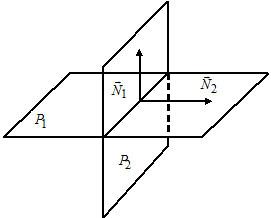Mutual arrangement of planes, angle between planes.
Condition of parallelism of two planes:
Let $P_1: A_1x+B_1y+C_1z+D_1=0,$ $\overline{N}_1=(A_1, B_1, C_1);$
$P_2: A_2x+B_2y+C_2z+D_2=0,$ $\overline{N}_2=(A_2, B_2, C_2).$
Planes $P_1$ and $P_2$ are parallel if and only if $\overline{N}_1\parallel\overline{N}_2\Leftrightarrow$ $\frac{A_1}{A_2}=\frac{B_1}{B_2}=\frac{C_1}{C_2}.$

Condition for perpendicularity of two planes:
Let $P_1: A_1x+B_1y+C_1z+D_1=0,$ $\overline{N}_1=(A_1, B_1, C_1);$
$P_2: A_2x+B_2y+C_2z+D_2=0,$ $\overline{N}_2=(A_2, B_2, C_2).$
$P_1\perp P_2\Leftrightarrow$ $\overline{N}_1\perp\overline{N}_2\Leftrightarrow$ ${A_1}\cdot{A_2}+{B_1}\cdot{B_2}+C_1\cdot C_2=0.$

Angle between planes:
Let $P_1: A_1x+B_1y+C_1z+D_1=0,$ $\overline{N}_1=(A_1, B_1, C_1);$
$P_2: A_2x+B_2y+C_2z+D_2=0,$ $\overline{N}_2=(A_2, B_2, C_2).$
$\cos\widehat{(P_1, P_2)}=$ $\frac{\overline N_1\cdot \overline N_2}{|\overline N_1||\overline N_2|}=$ $\frac{{A_1}\cdot{A_2}+{B_1}\cdot{B_2}+C_1\cdot C_2}{\sqrt{A_1^2+B_1^2+C_1^2}\cdot\sqrt{A_2^2+B_2^2+C_2^2}}.$

Examples.
In the tasks, investigate the mutual arrangement of the given planes. In the case of $P_1\parallel P_2$, find the distance between the planes, and in the case of perpendicularity, find the cosine of the angle between them.
2.185. $P_1: -x+2y-z+1=0;$ $P_2: y+3z-1=0.$
Solution.
Let's calculate the angle between the given planes.
$P_1: -x+2y-z+1=0, \Rightarrow\overline{N}_1=(-1, 2, -1);$
$P_2: y+3z-1=0, \Rightarrow\overline{N}_2=(0, 1, 3).$
Then
$\cos\widehat{(P_1, P_2)}=$ $\frac{\overline N_1\cdot \overline N_2}{|\overline N_1||\overline N_2|}=$ $\frac{-1\cdot 0+2\cdot1-1\cdot 3}{\sqrt{(-1)^2+2^2+(-1)^2}\cdot\sqrt{0^2+1^2+3^2}}=\frac{-1}{\sqrt{60}}=\frac{-1}{2\sqrt{15}}.$
Thus, the planes intersect, and the cosine of the shortest angle between the planes is
$\cos\widehat{(P_1, P_2)}=-\frac{1}{2\sqrt{15}}.$
Answer: The planes intersect. $\cos\widehat{(P_1, P_2)}=-\frac{1}{2\sqrt{15}}.$
2.187. $P_1: x-y+1=0;$ $P_2: y-z+1=0.$
Solution.
Let's calculate the angle between the given planes.
$P_1: x-y+1=0, \Rightarrow\overline{N}_1=(1, -1, 0);$
$P_2: y-z+1=0, \Rightarrow\overline{N}_2=(0, 1, -1).$
Then
$\cos\widehat{(P_1, P_2)}=$ $\frac{\overline N_1\cdot \overline N_2}{|\overline N_1||\overline N_2|}=$ $\frac{1\cdot 0+(-1)\cdot1+0\cdot (-1)}{\sqrt{(1)^2+(-1)^2+0^2}\cdot\sqrt{0^2+1^2+(-1)^2}}=\frac{-1}{\sqrt{4}}=\frac{-1}{2}.$
Thus, the planes intersect, and the cosine of the shortest angle between the planes is
$\cos\widehat{(P_1, P_2)}=\frac{1}{2}.$
Answer: The planes intersect. $\cos\widehat{(P_1, P_2)}=\frac{1}{2}.$
2.196. Construct the equation of the plane $P,$ passing through the point $A(1, 1, -1)$ and perpendicular to the planes $P_1: 2x-y+5z+3=0$ and $P_2: x+3y-z-7=0.$
Solution.
For the plane $P$ to be perpendicular to the planes $P_1$ and $P_2,$ it needs to be parallel to their normal vectors $N_1$ and $N_2.$ Or, equivalently, perpendicular to the cross product $[N_1, N_2]$
$P_1: 2x-y+5z+3=0, \Rightarrow\overline{N}_1=(2, -1, 5);$
$P_2: x+3y-z-7=0, \Rightarrow\overline{N}_2=(1, 3, -1).$
$[N_1, N_2]=\begin{vmatrix}i&j&k\\2&-1&5\\1&3&-1\end{vmatrix}=i(1-15)-j(-2-5)+k(6+1)=$ $=-14i+7j+7k.$
Now let's write the equation of the plane passing through the given point $A(1, 1, -1)$ and perpendicular to the vector $[N_1, N_2]=(-14, 7, 7):$
$-14(x-1)+7(y-1)+7(z+1)=0 \div 7$
$-2(x-1)+y-1+z+1=0$
$-2x+y+z+2=0.$
Answer: $-2x+y+z+2=0.$
Homework.
In the problems, investigate the mutual arrangement of the given planes. In the case of $P_1\parallel P_2$, find the distance between the planes, and in the case they are not parallel, find the cosine of the angle between them.
2.186. $P_1: 2x-y+z-1=0;$ $P_2: -4x+2y-2z-1=0.$
2.188. $P_1: 2x-y-z+1=0;$ $P_2: -4x+2y+2z-2=0.$
Tags: Mutual arrangement of planes, angle between planes, geometry, plane in space


